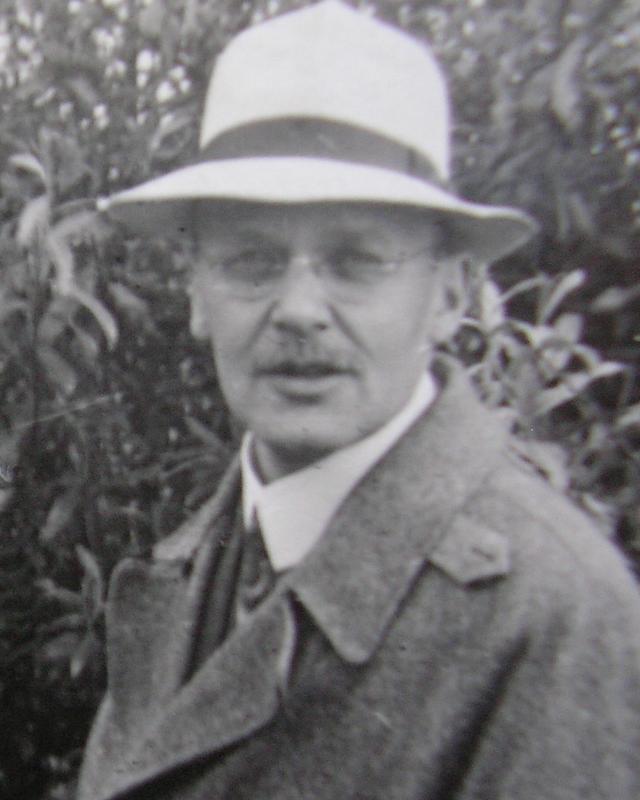 |
| Hans Geiger (1882 - 1945) |
Hans Geiger was born in Germany and received his PhD from the University of Erlangen in 1906. After graduating, he went to England to work at the University of Manchester with Ernest Rutherford (1871-1937), who won the 1908 Nobel Prize in physics for his work with radioactive substances. One of the first projects that Geiger collaborated on in Rutherford's lab was the famous gold foil experiment, also called the Geiger-Marsden experiment (Marsden was an undergrad working with Geiger) or the Rutherford experiment. In this experiment, where helium nuclei (alpha particles) were fired at a thin sheet of gold, Rutherford hoped to better understand the actual composition of atoms. When some of the particles deflected at very high angles, a reasonable explanation was that rather than having the mass of an atom spread fairly evenly, there must be a highly concentrated nucleus to an atom. This experiment was vital to the modern understanding of the structure of the atom.
Geiger continued to work with alpha-particles, developing the first detector for alpha particles in 1908. This consisted of a wire in a low pressure chamber with a voltage applied across the wire and the outside of the tube. The voltage is high enough that a current can almost, but not quite, flow through the gas. When an ionizing particle came into contact with the wire, it disturbs the system enough to complete the circuit, and the resulting completion can be detected by an audible click or by a pointer, depending on the type of counter. Design variables included the applied voltage, the pressure inside the chamber, and the length and diameter of the tube. Geiger continued to try to make more sensitive devices, and in 1913, after returning to Berlin to work at the German National Institute for Science and Technology, created a more sensitive device that used a needle that stuck into the middle of the detecting tube, rather than a wire connected at both ends. This version was able to detect both alpha and beta particles.
Geiger served as an artillery officer during World War I, and when he returned to direct radiation research at the University of Kiel and the University of Tübingen, and later at Technische Hochschule in Berlin. It was while working with a post-doc, Walther Müller, at Kiel, that the next breakthrough in the Geiger counter occurred. Geiger wanted Müller to determine the precise effect of a positive ion on the counter, and in general to test different configurations, voltages, polarities, etc. It was as a result of this that Müller discovered a configuration that lead to an increase in sensitivity of about 100 times, which is why in many publications and discussions of Geiger counters, one finds them called Geiger-Müller counters. The increased sensitivity of this counter made them more useful for the detection of cosmic rays, which were a subject of much interest around that time. They could also be combined with cloud chambers to watch electrons moving individually.
After this discovery, the sources that I have found don't talk about what Geiger did next much. He continued researching radiation in various forms, including cosmic rays and nuclear fission. He was involved in the German efforts to create a nuclear bomb, and died a few months after World War II ended. What I find most interesting about his story is that he, more than many of the other people that I have written about so far, worked in collaborations. The gold-foil experiment was done with Marsden, but the conclusions about the atom were Rutherford's. The improved Geiger counter was the work of a student. I think this way of doing research is much more what we are familiar with today, when papers can have ten co-authors and, especially as a graduate student, one's advisor's name is on everything. Clearly, Geiger made important contributions, but he was not working alone.
Works by Geiger
- Hans Geiger, Strahlungs-, Temperatur- und Potentialmessungen in Entladungsröhren bei starken Strömen, Annalen der Physik, 327, 5 (1907), 973-1007. doi: 10.1002/andp.19073270507.
- Ernest Rutherford and Hans Geiger, The Charge and Nature of the Alpha-Particle, Proceedings of the Royal Society of London A, 81 (1908), 162-173. doi: 10.1098/rspa.1908.0066.
- Hans Geiger, The Irregularities in Radiation from Radioactive Bodies, Philosophical Magazine Series 6, 15, 88 (1908), 539-547. doi: 10.1080/14786440809463795.
- Hans Geiger, The Scattering of Alpha-Particles by Matter, Proceedings of the Royal Society of London A, 83 (1910), 492-504. doi: 10.1098/rspa.1910.0038.
- Hans Geiger and Walther Müller, "Elektronenzahlrohr zur Messung schwachster Aktivitaten (Electron counting tube for the measurement of the weakest radioactivities)". Die Naturwissenschaften (The Sciences) 16, 31 (1928), 617-618. doi: 10.1007/BF01494093.
References and Further Reading
- "Hans Geiger". Encyclopædia Britannica Online. Encyclopædia Britannica Inc., 2012. Accessed July 13, 2012.
- Thaddeus Trenn, "The Geiger-Müller Counter of 1928", Annals of Science 43, 2 (1986), 111-135.
- "Geiger Counter", Lemelson-MIT Inventor of the Week, February 2005.
- M. Walter and A. W. Wolfendale, "Early history of cosmic particle physics", The European Physical Journal H (2012). doi: 10.1140/epjh/e2012-30020-1
- Paul Frame, "A history of radiation detection instrumentation", Health Physics 88, 6 (2005), 613-637.